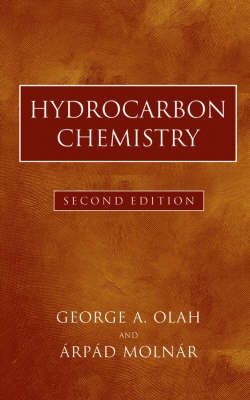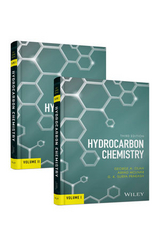
Hydrocarbon Chemistry
John Wiley & Sons Inc (Verlag)
978-0-471-41782-8 (ISBN)
- Titel erscheint in neuer Auflage
- Artikel merken
Other topics covered include:* Major processes of the petrochemical industry, such as cracking, reforming, isomerization, and alkylation * Derivation reactions to form carbon-heteroatom bonds * Hydrocarbon oxidations * Metathesis * Oligomerization and polymerization of hydrocarbons All chapters have been updated by adding sections on recent developments to review new advances and results. Essential reading for practicing scientists in industry, polymer and catalytic chemists, as well as researchers and graduate students, Hydrocarbon Chemistry, Second Edition remains the benchmark text in its field.
GEORGE A. OLAH, PhD, was awarded the 1994 Nobel Prize in Chemistry for his work in hydrocarbon chemistry. He is Director of the Loker Hydrocarbon Research Institute at the University of Southern California in Los Angeles. ARPAD MOLNAR, PhD, is Professor in the Department of Organic Chemistry at the University of Szeged, Hungary.
Preface to the Second Edition. Preface to the First Edition. Introduction. Chapter 1. General Aspects. 1.1. Hydrocarbons and Their Classes. 1.2. Energy-Hydrocarbon Relationship. 1.3. Hydrocarbon Sources and Separation. 1.4. Petroleum Refining and Upgrading. 1.5. Finite, Nonrenewable Hydrocarbon Resources. 1.6. Hydrocarbon Synthesis. 1.7. Chemical Nature of Hydrocarbon Conversion Reactions. 1.8. Use of Hydrocarbons. References and Notes. Chapter 2. Hydrocarbon from Petroleum and Natural Gas. 2.1. Cracking. 2.2. Reforming. 2.3. Dehydrogenation with Olefin Production. 2.4. Upgrading of Natural-Gas Liquids. 2.5. Aromatics Production. 2.6. Recent Developments. References. Chapter 3. Synthesis from C1 Sources. 3.1. Nature's C1 Chemistry. 3.2. The Chemical Reduction and Recycling of CO2. 3.3. Fischer-Tropsch Chemistry. 3.4. Direct Coupling of Methane. 3.5. Hydrocarbons through Methane Derivatives. 3.6. Recent Developments. References. Chapter 4. Isomerization. 4.1. Acid-Catalyzed Isomerization. 4.2. Base-Catalyzed Isomerization. 4.3. Metal-Catalyzed Isomerization. 4.4. Pericyclic Rearrangements. 4.5. Practical Applications. 4.6. Recent Developments. References. Chapter 5.1 Alkylation. 5.1. Acid-Catalyzed Alkylation. 5.2. Base-Catalyzed Alkylation. 5.3. Alkylation through Organometallics. 5.4. Miscellaneous Alkylations. 5.5. Practical Applications. 5.6. Recent Developments. References. Chapter 6. Addition. 6.1. Hydration. 6.2. HX addition. 6.3. Halogen Addition. 6.4. Ammonia and Amine Addition. 6.5. Hydrometallation. 6.6. Halometallation. 6.7. Solvometallation. 6.8. Carbometallation. 6.9. Cycloaddition. 6.10. Recent Developments. References. Chapter 7. Carbonylation. 7.1. Hydroformylation. 7.2. Carboxylation. 7.3. Aminomethylation. 7.4. Recent Developments. References. Chapter 8. Acylation. 8.1. Acylation of Aromatics. 8.2. Related Acylations. 8.3. Acylation of Aliphatic Compounds. References. Chapter 9. Oxidation-Oxygenation. 9.1. Oxidation of Alkanes. 9.2. Oxidation of Alkenes. 9.3. Oxidation of Alkynes. 9.4. Oxidation of Aromatics. 9.5. Practical Applications. 9.6. Recent Developments. References. Chapter 10. Heterosubstitution. 10.1. Electrophilic (Acid-Catalyzed) Substitution. 10.2. Free-Radical Substitution. 10.3. Amination. 10.4. Heterosubstitution through Organometallics. 10.5. Recent Developments. References. Chapter 11. Reduction-Hydrogenation. 11.1. Heterogeneous Catalytic Hydrogenation. 11.2. Homogeneous Catalytic Hydrogenation. 11.3. Chemical and Electrochemical Reduction. 11.4. Ionic Hydrogenation. 11.5. Hydrogenolysis of Saturated Hydrocarbons. 11.6. Practical Applications. 11.7. Recent Developments. References. Chapter 12. Metathesis. 12.1. Acyclic Alkenes. 12.2. Ring-Opening Metathesis Polymerization. 12.3. Practical Applications. 12.4. Recent Developments. References. Chapter 13. Oligomerization and Polymerization. 13.1. Oligomerization. 13.2. Polymerization. 13.3. Recent Developments. References. Chapter 14. Emerging Areas and Trends. 14.1. Green Chemistry. 14.2 Carbon Dioxide Recycling to Hydrocarbons References. Index.
| Erscheint lt. Verlag | 20.5.2003 |
|---|---|
| Verlagsort | New York |
| Sprache | englisch |
| Maße | 162 x 245 mm |
| Gewicht | 1344 g |
| Themenwelt | Naturwissenschaften ► Chemie ► Organische Chemie |
| ISBN-10 | 0-471-41782-3 / 0471417823 |
| ISBN-13 | 978-0-471-41782-8 / 9780471417828 |
| Zustand | Neuware |
| Haben Sie eine Frage zum Produkt? |
aus dem Bereich



